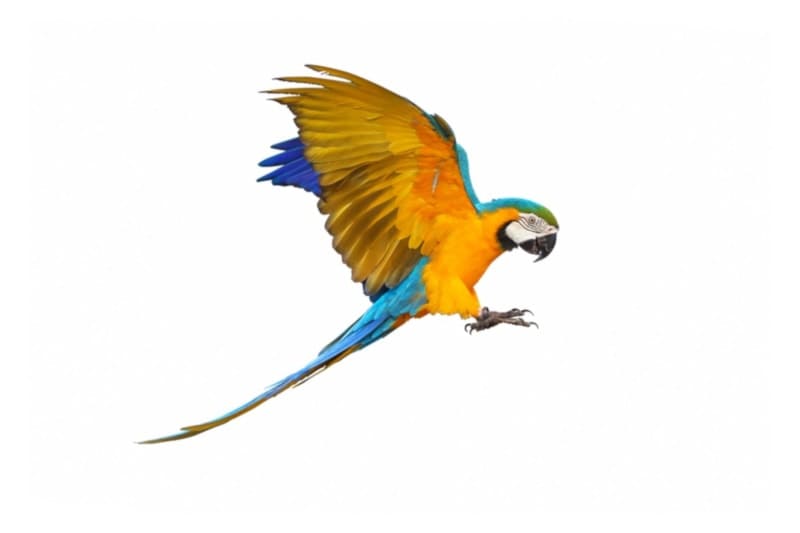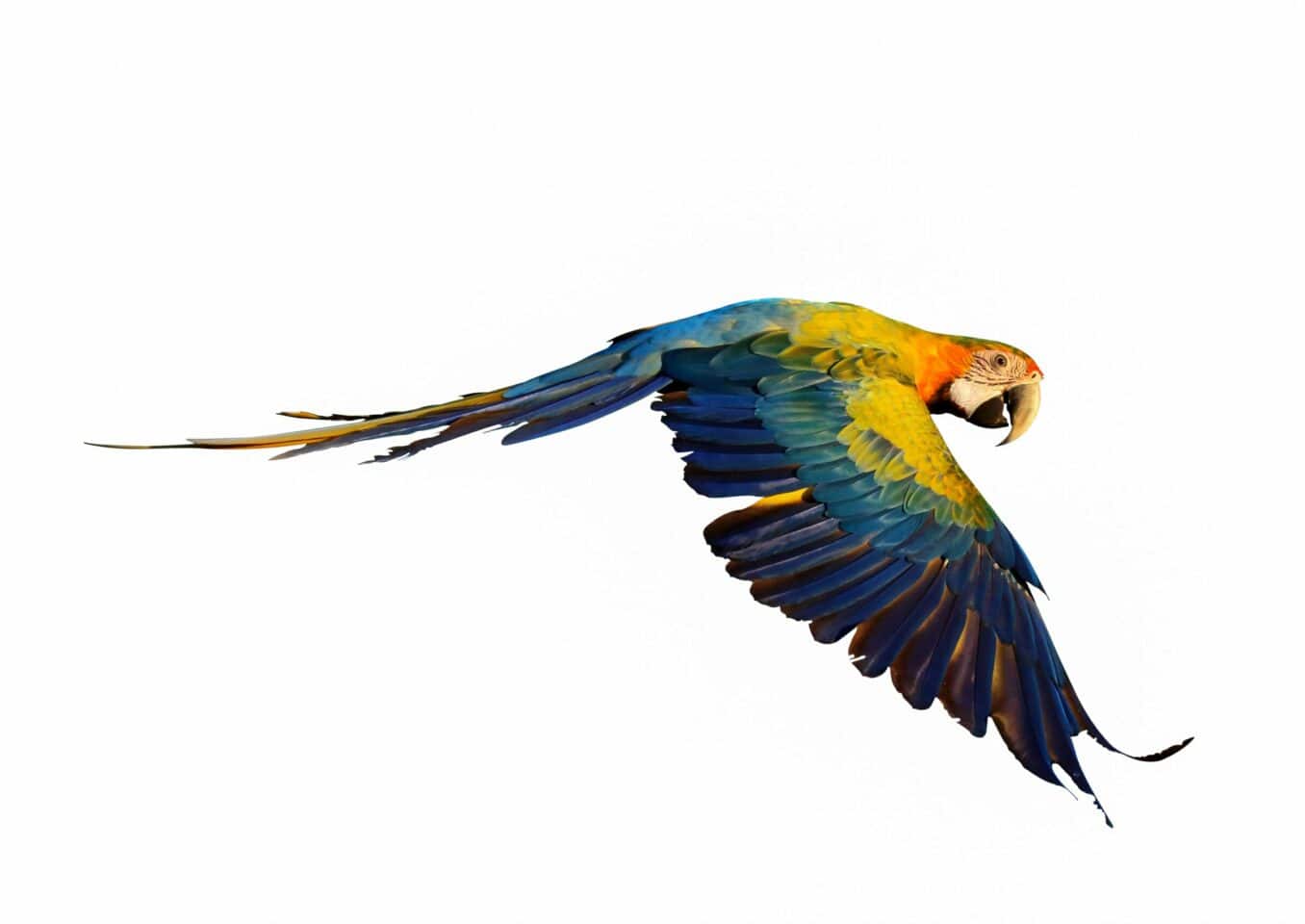The Camelot macaw is a hybrid between the Scarlet and Golden-blue macaw. Since these birds are hybrids, they do not have a scientific name. Camelot macaws are brightly colored and attractive. This is a captive-bred macaw that is not naturally found in the wild. They are a relatively new color mutation of the first-generation macaw. Macaws are highly intelligent and interactive. They enjoy learning new words and sounds to add to their vocabulary. The Camelot macaw is more readily available than most color mutations of the macaw bird.
This article will provide you with all the information you need to know when it comes to caring for the stunning Camelot macaw bird.
 Species Overview
Species Overview
| Common Names: | Catalina or rainbow macaw |
| Scientific Name: | Hybrid (Ara ararauna x Ara macao) |
| Adult Size: | 30-35 inches |
| Life Expectancy: | 50-60 years |
Origin and History
The crossbreeding between the Catalina and Scarlet macaw has led to the creation of the rainbow-colored hybridized Camelot macaw. These macaws are mainly found in captivity and have been bred in the pet trade industry for several years. The name of the Camelot macaw is derived from two true species of macaws that were bred for their coloration and not their personality. It is also common to find second-generation Catalina macaws that have been crossed between two Catalina parents.
Since Camelot macaws are seldom found in the wild, their natural origin is based on the original macaw bird species. They inhabit woodlands and swampy forests throughout different regions. They are at risk of losing their habitat due to human destruction and deforestation.

Temperament
Both parent Camelot macaws have unique personalities that are brought out in their offspring. The scarlet macaw is active, vocal, and highly intelligent. Whereas the golden-blue macaw bird is social and has a similar intellect. Their overall personality is unpredictable since they are hybrids. They can either have a mixture of their parent’s personalities, or their uncertain behavior and quirks. They mimic sounds and experiences in their environment, which means they should be calm and controlled. If the environment is noisy and busy, the Camelot macaw will develop unwanted personality traits.
- Colorful and intelligent
- New hybrid mutation
- Friendly and easy to train
- Noisy and vocal
- Require extremely large cages to be content
Speech & Vocalizations
If you are looking for a bird that is easy to train in terms of vocals, then the Camelot macaw is a perfect match for you. Macaws can develop a strong vocabulary of human words, phrases, songs, and other sounds that they frequently hear. This can be both a pro and a con because they can easily mimic sounds within the household like a ringing telephone or the noise from a child’s toy which can annoy many owners. Yet they can also learn affectionate words like greetings or short sentences they hear from their owners.
Camelot Macaw Colors and Markings
Camelot macaws have successfully contributed their hybridized genes to many different colorful macaw hybrids in captivity. Breeders have created some beautiful second-generation macaws from this beautiful macaw.
- Camelina: A second-generation hybrid of a Camelot macaw mixed with a Catalina.
- Catablu: Golden-blue macaw crossbred with a Catalina.
- Flame: The green-wing macaw bred with a Catalina macaw.
- Milicat: The hybrid miligold macaw bred with a Catalina.
- Rubalina: A Catalina macaw crossbred with a ruby macaw hybrid.
- Shamalina: The shamrock macaw mixed with a Catalina macaw.
- Maui sunrise: Catalina macaw crossbred with a harlequin macaw hybrid.
 Caring for the Camelot Macaw
Caring for the Camelot Macaw
Companionship
If you plan to keep more than one macaw, they should be familiar with each other from a young age. This helps them to form a bond that will also help prevent future fights and bouts of aggression. The cage size will also have to be increased if you keep your Camelot macaw with a partner. Breeding pairs are recommended and have a higher success rate at maintaining a bond. Macaws do not have to be kept in large groups like other types of pet birds.

Cage size
Macaws are large growing birds that grow to an average size of 30 inches in length. The cage should be large enough to accommodate their size. The minimum sized cage for a Camelot macaw is 100 inches in length and 200 inches in height. The best housing option for the Camelot macaw is an outside aviary. This should have a shelter with various hiding spots so that the macaw can escape the elements.
Enrichment
These birds are inquisitive and have large beaks that should be maintained with a variety of toys that they can chew on. Not only do toys and other interactive activities provide your bird with something to do, but it also provides them with mental stimulation which helps to prevent boredom and stress which are two common issues in birds kept in a poorly enriched environment.

Common Health Problems
Camelot hybrid macaws seem to be the most prone to developing the following health issues. If you notice that your macaw is unwell, they should be taken to an emergency avian vet for prompt treatment.
| Weight loss: | Consistent with a poor diet or chronic diarrhea. |
| Respiratory distress: | This can happen if they are exposed to cold and wet environments, cold droughts, and an unclean enclosure that holds a strong ammonia smell. |
| Diarrhea: | A diet that contains too many watery fruits can cause stool complications. Diarrhea can also be caused by certain bacteria found in a dirty environment. |
| Sinus infections: | A runny nose and watery eyes are common symptoms. Clear or colored discharge may leak onto their beak from their nares. |
| Chronic depression: | A bored, neglected, stressed, or anti-social Camelot macaw can develop a form of depression similar in humans. |
| Herpes: | This can cause proliferative lesions and depigmentation. |
| Feather plucking: | A bored and stressed macaw will pluck out its feathers. This typically occurs along the stomach area. |
| Cloacal Papillomas: | This is a viral sexually transmitted disease that infects parrots. |
| Kidney disease: | Mainly caused by feeding toxic foods over a long period. |
Diet and Nutrition
These birds are strictly frugivores and granivores. Their wild diet consists of fruits, nuts, seeds, insects, and other similar foods they can find. Their wild diet should be replicated in captivity to ensure that they are kept healthy. A high-quality commercial macaw diet should be their primary source of nutrition. You should supplement the diet with tree nuts and small amounts of fresh fruits. It is recommended to mix at least two different types of pellets and seed mixes to ensure that they are receiving enough nutrients. Camelot macaws are more susceptible to health issues if their diet is deficient in certain minerals and vitamins.
Where to Buy a Camelot Macaw
These beautiful birds can be purchased from a breeder or pet store. You will find healthier and more vibrant Camelot macaws from a high-grade breeder. This can cost slightly more, but it is worth it as breeders typically have healthier birds with strong immune systems. Breeders can also give insight into the genetic details of the parents so that you can be prepared for any behavioral issues or characteristics that can be inherited from the parents. Most pet stores sell low-grade Camelot macaws from breeding mills, but this is usually avoidable in family-owned pet stores that focus more on the quality of their livestock than the quantity.
 In Conclusion
In Conclusion
Camelot macaws are attractive birds that make great pets to those who can provide them with the right care requirements. Many macaw owners will describe their Camelot macaw as their child, which shows the strong bond that these birds form with their owners. These social birds can live for years with the right care and are life-long pets.
We hope that this article has helped inform you of everything you need to know about the Camelot macaw!
Featured Image Credit: Passakorn Umpornmaha, Shutterstock
